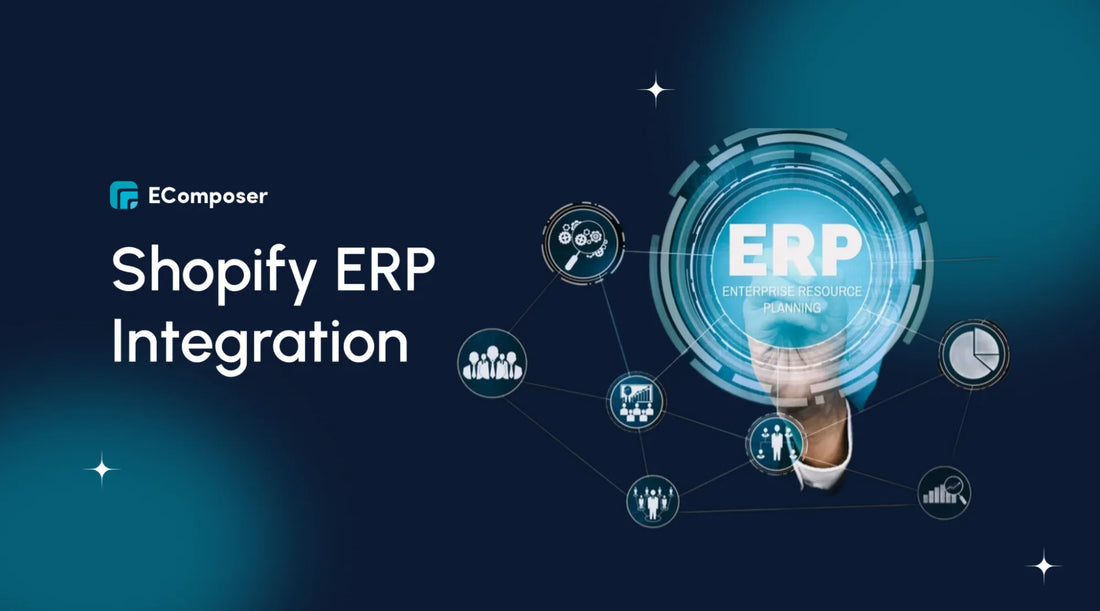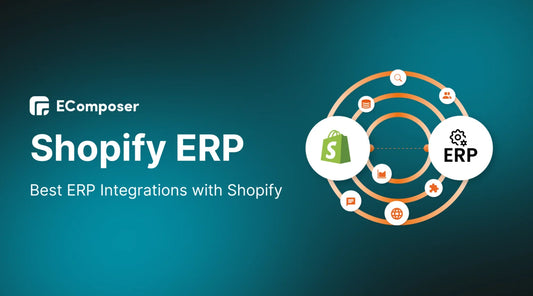Shopify ERP Integration: All you need to know

Table Of Contents
In today’s competitive eCommerce landscape, effective management is crucial for success. Shopify ERP integration streamlines your operations by connecting inventory, order processing, and customer data in one cohesive system. This not only enhances efficiency but also boosts customer satisfaction. In this blog, we’ll explore the ins and outs of Shopify ERP integration, including its benefits, key features, and tips for selecting the right solution for your business. Let’s get started!
What is Shopify ERP?

Shopify ERP (Enterprise Resource Planning) refers to the integration of an ERP system with your Shopify store to streamline and automate business operations. An ERP system connects various functions like inventory management, order processing, accounting, customer data, and supply chain operations into one centralized platform. For Shopify merchants, this integration helps improve efficiency by automating tasks, reducing manual errors, and providing real-time insights into business performance, enabling better decision-making and scalability as your store grows.
Key benefits of using Shopify ERP
-
Centralized Data Management
ERP integration consolidates data from different departments (inventory, sales, accounting) into one platform, giving you real-time insights. -
Automated Processes
Streamline tasks like order fulfillment, inventory updates, and invoicing, reducing manual work and errors. -
Improved Inventory Control
Keep accurate stock levels, avoid overselling, and manage restocking with ease, ensuring better supply chain management. -
Enhanced Customer Experience
Faster order processing, real-time tracking, and improved communication lead to higher customer satisfaction. -
Scalability
Easily manage business growth with a system that scales alongside your Shopify store, adapting to increased demand. -
Financial Management
Automate bookkeeping, invoicing, and financial reporting, helping you stay on top of cash flow and taxes.
Popular ERP solutions for your Shopify stores
1. Cloud-Based ERPs
NetSuite

https://www.netsuite.com/portal/home.shtml
NetSuite is a leading cloud-based ERP that offers a comprehensive suite of features tailored for eCommerce businesses. Its powerful tools help manage financials, inventory, and customer relationships in one platform. This flexibility makes it a popular choice for growing Shopify merchants seeking to streamline operations and improve scalability.
- Key Features:
- Real-time inventory and order management
- Financial and revenue recognition tools
- Customer relationship management (CRM)
- Pros:
- Highly scalable to accommodate growth
- Robust reporting and analytics capabilities
- Integrates with various business applications
- Cons:
- Higher costs, which may be prohibitive for smaller businesses
2. Integrated ERP Solutions
Microsoft Dynamics 365

https://www.microsoft.com/en-us/dynamics-365
Microsoft Dynamics 365 combines ERP and CRM functionalities, making it a powerful tool for Shopify merchants. It helps manage everything from finance to operations and sales, enabling a comprehensive view of business performance. The integration capabilities with other Microsoft tools make it appealing for businesses already in the Microsoft ecosystem.
- Key Features:
- Unified customer data across sales and service
- Advanced analytics and business intelligence
- Customizable workflows and processes
- Pros:
- Seamless integration with Microsoft Office products
- Highly customizable to meet specific business needs
- Strong support and community resources
- Cons:
- Steeper learning curve for new users
- Higher costs can be challenging for small businesses
3. Open-Source ERPs
Odoo

Odoo is an open-source ERP solution that offers modular features tailored to various business functions. This flexibility allows Shopify merchants to customize the system according to their specific needs, whether it’s for inventory, sales, or accounting. Odoo’s extensive app marketplace makes it easy to add functionalities as your business grows.
- Key Features:
- Modular applications for sales, inventory, accounting, and more
- User-friendly interface and customizable workflows
- Built-in eCommerce capabilities
- Pros:
- Cost-effective solution with various pricing options
- Highly flexible and customizable
- Strong community support and regular updates
- Cons:
- Can require technical expertise for setup and customization
- Some advanced features may be limited compared to paid ERPs
4. Retail-Focused ERPs
Brightpearl

Brightpearl is specifically designed for retail and eCommerce businesses, making it an ideal ERP for Shopify merchants. It automates essential back-office tasks like accounting, inventory management, and order processing, enabling business owners to focus on growth and customer satisfaction.
- Key Features:
- Automated inventory management and order processing
- Financial management tools for accounting
- Real-time reporting and analytics
- Pros:
- Retail-focused features that cater to eCommerce needs
- User-friendly interface that simplifies operations
- Excellent customer support and resources
- Cons:
- May lack advanced features for non-retail businesses
- Can be costly for startups with limited budgets
5. Inventory Management ERPs
TradeGecko (QuickBooks Commerce)

https://www.ordoro.com/tradegecko-inventory
TradeGecko, now known as QuickBooks Commerce, focuses on inventory and order management for eCommerce businesses. This solution provides Shopify merchants with essential tools to streamline inventory tracking, order processing, and sales analytics, making it easier to manage stock and improve sales efficiency.
- Key Features:
- Inventory management across multiple channels
- Order management and fulfillment tools
- Integration with QuickBooks for seamless accounting
- Pros:
- Strong focus on inventory management
- Easy integration with Shopify and QuickBooks
- Simplified order processing and fulfillment
- Cons:
- Best suited for inventory-heavy businesses, limiting its use for service-based companies
- Some features may be lacking compared to more comprehensive ERPs
Choosing the Right Shopify ERP for your online business
Selecting the suitable ERP for your Shopify store can feel overwhelming, given the range of options available. However, a well-chosen ERP can revolutionize your business operations by centralizing data, automating workflows, and providing valuable insights. Here’s what to consider when choosing a Shopify ERP that best fits your needs:
Define Your Business Need
First, determine your specific requirements. Are you looking for detailed inventory tracking, streamlined financial management, or enhanced customer relationship management? Identifying your priorities helps you narrow down the ERP systems that align with your business objectives. For example:
- For inventory-heavy businesses: Choose a solution like TradeGecko.
- For growing businesses needing scalability: Consider NetSuite or Dynamics 365.
Assess Scalability
Your ERP should grow with your business. While some ERPs like Brightpearl are ideal for small to medium businesses, others like Microsoft Dynamics 365 can handle complex, expanding operations. Think about your business trajectory and opt for a system that can adapt to increased demand without requiring constant upgrades.
Consider Integration Capabilities
A strong ERP will seamlessly integrate with your Shopify store and other essential tools like accounting software, CRMs, or marketing platforms. Ensure that the ERP you choose offers easy integration with Shopify to prevent data silos and streamline operations.
Evaluate Customization and Flexibility
Every business has unique needs. Some ERPs, like Odoo, offer open-source customization, allowing you to tailor workflows, reports, and features to match your business processes. Customization options can be precious for niche businesses needing specific functionalities.
Review Costs and Pricing Structure
ERP systems vary widely in price. Some offer modular pricing (like Odoo) that lets you pay only for what you use, while others are more comprehensive and may come with a higher upfront cost. Factor in both initial costs and any ongoing subscription fees and look for a solution that balances features with affordability.
User-Friendliness and Support
An ERP should simplify, not complicate, your business processes. Choose a system with an intuitive interface, as well as ample training resources, documentation, and customer support. If your team is new to ERP systems, options like Brightpearl and TradeGecko are known for their user-friendly designs.
Look for Industry-Specific Features
Some ERPs cater to specific industries better than others. Brightpearl, for instance, is ideal for retail, while Odoo is suited for companies wanting modular options across diverse industries. Consider ERP solutions with industry-specific tools to maximize productivity and accuracy.
Test the Software Before Committing
Many ERP providers offer demos or trial versions—make use of these! Testing the software allows you to see firsthand how it integrates with your Shopify store, handles data, and supports your daily operations.
7 Simple Steps to Integrate ERP with Shopify

Step 1: Choose the Right ERP Solution
- Research Options: Identify ERP solutions compatible with Shopify, such as NetSuite, Microsoft Dynamics 365, or Odoo.
- Evaluate Features: Look for essential features like inventory management, financial tracking, and CRM capabilities that align with your business needs.
- Check Integration Capabilities: Ensure the ERP has built-in integration with Shopify or supports third-party integration tools.
- Consider User Reviews: Read user testimonials and case studies to gauge the experiences of others in your industry.
Step 2: Set Up Your Shopify Store and ERP System
- Create Your Shopify Store: Ensure your Shopify store is fully set up with products, categories, and payment methods.
- Configure ERP Settings: Set up the ERP system with foundational data, including:
- Product SKUs: Ensure all products in Shopify have corresponding SKUs in the ERP.
- Customer Profiles: Import customer data and configure customer relationship features.
- Tax Settings: Set up tax rules according to your business location and sales practices.
Step 3: Map Your Data Fields
- Identify Key Data Points: Determine which data needs syncing between Shopify and your ERP, including:
- Inventory levels
- Order details (items, quantities, status)
- Customer information (name, address, purchase history)
- Create a Mapping Document: Document how fields in Shopify correspond to fields in the ERP to maintain consistency during integration.
Step 4: Use a Third-Party Integration Tool (if needed)
- Select an Integration Tool: If direct integration isn’t available, consider tools like:
- Zapier: Automate tasks between Shopify and your ERP.
- Celigo: Provides pre-built connectors for various ERP systems.
- Automate.io: Create workflows to sync data between Shopify and your ERP.
- Install the Integration Tool: Follow setup instructions to link your Shopify store and ERP through the selected tool.
Step 5: Test the Integration with Sample Data
- Conduct Initial Tests: Place test orders in Shopify and check how they reflect in the ERP.
- Adjust Inventory: Update stock levels in Shopify and verify that these changes sync accurately with the ERP.
- Verify Customer Data: Ensure that customer information updates in both systems without discrepancies.
- Review Error Logs: Check integration logs for any errors or warnings that need addressing.
Step 6: Set Automation Rules and Workflows
- Create Automation Rules: Configure the ERP to automate routine tasks, such as:
- Updating inventory levels when orders are placed or canceled.
- Automatically generate invoices for completed orders.
- Sending alerts for low stock levels to streamline restocking processes.
- Customize Workflows: Depending on your business needs, customize workflows for order fulfillment, shipping, and reporting.
Step 7: Monitor and Optimize
- Regularly Review Data Flow: Monitor data transfers between Shopify and the ERP for accuracy and efficiency.
- Conduct Periodic Audits: Regularly audit both systems to ensure data integrity and identify any integration issues.
- Update Systems: Stay informed about updates in Shopify and your ERP system that may impact integration, and adjust configurations as necessary.
- Gather User Feedback: Solicit feedback from your team on the integration process and address any concerns or challenges they encounter.
Following this detailed guide will help you effectively integrate ERP with Shopify, enhancing your operational efficiency and providing a seamless experience for your customers.
Best Practices for Using Shopify ERP Effectively

Thoroughly Understand Your ERP System
- Training: Invest time in training your team on how to use the ERP system effectively. Familiarize them with its features and functionalities.
- Documentation: Utilize the documentation and support resources provided by the ERP vendor to understand advanced features and troubleshooting steps.
Regular Data Maintenance
- Data Accuracy: Keep your product information, customer data, and inventory levels updated in both Shopify and the ERP. Regularly verify that data is syncing correctly.
- Data Cleanup: Periodically audit your data for duplicates, inaccuracies, or outdated information to maintain integrity.
Leverage Automation
- Automate Routine Tasks: Use automation features to handle repetitive tasks such as order processing, invoicing, and inventory updates. This reduces manual errors and saves time.
- Set Up Alerts: Configure alerts for low inventory levels, pending orders, or important deadlines to ensure timely actions are taken.
Optimize Inventory Management
- Real-Time Tracking: Ensure that inventory levels are tracked in real-time across all sales channels to prevent stockouts or overstock situations.
- Forecasting: Use the ERP’s forecasting tools to analyze sales trends and seasonal demand, enabling proactive inventory management.
Integrate with Other Tools
- Connect Relevant Apps: Integrate the ERP with other essential tools like accounting software, CRM systems, and marketing platforms for a cohesive operational ecosystem.
- Utilize API Capabilities: If applicable, leverage the ERP's API capabilities to customize integrations that suit your business needs.
Focus on Reporting and Analytics
- Utilize Reporting Features: Take advantage of the reporting features in your ERP to gain insights into sales performance, inventory turnover, and customer behavior.
- Make Data-Driven Decisions: Use the analytics to inform strategic decisions, such as marketing campaigns, inventory purchases, and pricing strategies.
Customize Workflows
- Tailor Processes: Customize workflows to align with your business processes, ensuring that the ERP supports your operational needs rather than forcing you to adapt to its limitations.
- Collaborate with Teams: Involve relevant teams in the customization process to ensure the system meets their requirements and enhances productivity.
Monitor Performance and Adapt
- Set Key Performance Indicators (KPIs): Define KPIs relevant to your business goals and regularly track them using the ERP’s analytics capabilities.
- Continuous Improvement: Regularly review performance metrics and seek areas for improvement, whether in processes, inventory management, or customer service.
Stay Updated
- Software Updates: Keep your ERP system updated to benefit from new features, security improvements, and bug fixes.
- Industry Trends: Stay informed about industry trends and best practices in eCommerce and ERP usage to maintain a competitive edge.
Provide Excellent Customer Support
- Use Customer Insights: Leverage data from the ERP to enhance customer support by understanding purchasing patterns and preferences.
- Responsive Service: Train your support team to use the ERP effectively, allowing them to provide timely and informed responses to customer inquiries.
Bottom line
In conclusion, integrating ERP with Shopify can significantly enhance your eCommerce operations by streamlining processes and improving data accuracy. By following the steps outlined in this guide and adhering to best practices, you can harness the full potential of your ERP system. This integration not only saves time and reduces errors but also equips your business with valuable insights, positioning you for growth in today’s competitive online marketplace. Embrace the change and watch your business thrive!






















0 comments